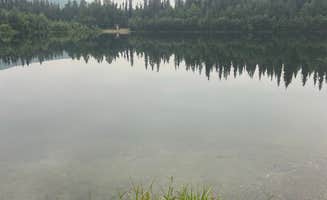Primitive camping near Eielson AFB, Alaska offers remote outdoor access in the subarctic climate zone where summer temperatures range from 50-80°F, with cooler nights even during peak season. These dispersed sites typically sit at elevations between 400-800 feet above sea level in the Tanana Valley region, characterized by boreal forest dominated by black spruce and birch trees. Access roads remain unpaved and narrow at most locations, requiring careful navigation.
What to do
Fishing opportunities: The two small lakes at Mile 48, Chena Hot Springs Road provide excellent fishing spots with minimal competition during weekdays. "We stopped here on our way out of Chena hot springs and went fishing. We were the only ones there and it was so peaceful," notes camper Riley N.
Wildlife observation: Bring binoculars for spotting local wildlife in the forest surroundings. Several campers report sightings at the forest-edge sites. At Elliott Highway Pulloff Loop, one camper noted, "We didn't even get out of our van because the mosquitoes were so bad though. We also saw two porcupines here as well."
Stargazing: During darker periods (late August through spring), the lack of light pollution makes these sites suitable for astronomy. The roadside areas provide better sky visibility than forested sites. James B. mentions the roadside camping spot has a "Good open area so solar and Starlink were happy."
What campers like
Peaceful midweek stays: Weekday visits offer significantly less crowded experiences at most primitive sites. As noted about Mile 48 Pond Camp, the lakes are "Busy on the weekends but empty during the week."
Solitude among natural settings: The dispersed camping areas provide isolation, particularly at tree-covered sites. At the Elliott Highway location, Riley N. describes the experience as "We were the only ones here and tucked away behind all of the trees and fireweed."
Accessibility to Chena Hot Springs: Several sites serve as convenient overnight stops when visiting the hot springs. Riley N. mentions, "We stopped here on our way out of Chena hot springs and went fishing."
What you should know
Limited facilities: No potable water or sanitation facilities exist at most sites. Bring all necessary supplies including water and waste disposal equipment.
Insect preparation: Summer months bring significant mosquito activity, especially in forested areas. Bug nets, repellent, and proper clothing are essential. At the roadside camping spot, James B. noted it "Was a little buggy when we were there."
Seasonal access considerations: Spring breakup (April-May) can create extremely muddy conditions on access roads. Winter camping requires specialized equipment and experience with subzero temperatures.
Cell service limitations: Connectivity decreases significantly as distance from Fairbanks increases. Download offline maps and prepare for limited communication options.
Tips for camping with families
Activity timing: Schedule outdoor activities during mornings and evenings when mosquitoes are less active. Afternoons can be spent inside vehicles or in screened areas.
Wildlife safety protocols: Store food securely and maintain appropriate distances from wildlife. Teach children proper wilderness behavior before arrival.
Emergency planning: The remote location requires comprehensive first aid preparation and evacuation plans. Fairbanks provides the nearest comprehensive medical facilities, which may be over an hour away from some sites.
Tips from RVers
Leveling challenges: Many sites require additional leveling equipment due to uneven terrain. James B. found the roadside spot offered "Easy to get level" conditions.
Solar power viability: Open areas provide sufficient sunlight for solar panel operation during summer months. The extended daylight hours (up to 21+ hours in June) maximize charging potential.
Turnaround space: Scout locations before committing, as some forest sites offer limited maneuvering room for larger vehicles. The roadside camping area is noted as being big-rig friendly with adequate turnaround space.


